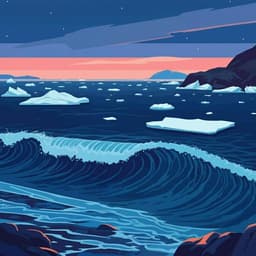
Earth Sciences
Arctic open-water periods are projected to lengthen dramatically by 2100
A. Crawford, J. Stroeve, et al.
This groundbreaking study by Alex Crawford, Julienne Stroeve, Abigail Smith, and Alexandra Jahn reveals that the Arctic's open-water period is projected to lengthen significantly with global warming, potentially surpassing six months each year. This vital research, critical to understanding climate change impacts at regional levels, challenges existing projections, suggesting they may be conservative as we approach alarming temperature thresholds.
~3 min • Beginner • English
Introduction
The study addresses how Arctic open-water periods—defined by the seasonal timing of sea ice retreat and advance—will evolve regionally under different levels of global warming. While pan-Arctic September sea ice extent has long been used as a climate indicator, stakeholders (e.g., shipping, fisheries, coastal communities) require regional and seasonal information on the open-water period. Observations since 1979 show lengthening open-water periods across most Arctic regions, driven by earlier retreat and especially later advance, with strong regional variability and implications for ecosystems, coastal erosion, and human activities. Previous projections (mostly CMIP5, high-emissions RCP8.5) suggested large increases in open-water duration, but the impacts at lower warming levels relevant to the Paris Agreement (e.g., 1.5–2 °C) had not been comprehensively assessed. This study quantifies regional changes in open-water periods and the timing of retreat/advance across 15 Arctic regions and key shipping routes, relating them to specific global temperature thresholds using CMIP6 simulations under multiple SSP scenarios.
Literature Review
Prior work documents rapid declines in Arctic sea ice extent and thickness and projects frequent ice-free Septembers around 2 °C warming, with ice-free Septembers possible even at 1.5 °C. Observed trends show lengthening open-water periods due to both earlier retreat and especially later advance, driven by ice–albedo–ocean heat uptake feedbacks. CMIP5-based studies under high emissions indicated continued lengthening dominated by later advance, with some regions exceeding six months of open water by 2100 and potential opening of the Transpolar Sea Route. However, assessments at lower warming levels (<4 °C) and stakeholder-relevant thresholds were limited. Recent analyses also indicate regional model biases in seasonal transition dates and uncertainties in observational SIC products, motivating careful model–observation comparisons and temperature-based sensitivity assessments.
Methodology
Datasets: Daily sea ice concentration (SIC) and monthly surface air temperature from CMIP6 models were used for historical and future scenarios (historical, SSP126, SSP245, SSP585). Only models with daily SIC for 1950–2014 (historical) and 2015–2100 (scenarios) were included; one model (CMCC-CM2-SR5) was excluded for unrealistic historical open-water periods. In total, 21 models were used (first realization per model for multi-model means). Observational comparisons used three daily SIC products (Bootstrap, NASA-Team, OSI SAF) for 1979–2014 and four global temperature datasets (Berkeley Earth, GISTEMP v4, HadCRUT4.6.0.0, NOAAGlobalTemp v5). Temperature anomalies are relative to 1850–1900, with extrapolation applied where needed to extend observational baselines to 1850.
Open-water period calculation: For a given SIC threshold (primarily 15%, also 80% in sensitivity tests), retreat day is the last time SIC falls below the threshold before the annual minimum; advance day is the first time SIC rises above the threshold after the minimum. A 5-day moving average is applied to daily SIC to reduce short-term fluctuations. The sea-ice year starts on the median day (Jan–Apr) when SIC equals the seasonal maximum to avoid bias near pack edges. The open-water period is the continuous time between retreat and advance; grid cells at extremes can exceed 365 days in individual years but average values converge below or at one year over longer periods.
Regional aggregation and metrics: The Arctic was divided into 15 regions plus pan-Arctic aggregates. Because retreat/advance dates become invalid where SIC is permanently above/below the threshold, regional metrics include the percent area open before the first day of given months (retreat) and percent area that remains open past the last day of given months (advance). Benchmark dates were chosen per region to minimize saturation at 0% or 100%. Trends and sensitivities were computed over 1979–2013 for historical comparisons.
Bias assessment and internal variability: Following SIMIP methodology, observational uncertainty was taken as the range across observational products; model internal variability was quantified using ensemble standard deviations adjusted for small sample sizes. Plausible simulations fall within x_obs ± 2σ_obs + σ_m. Multi-model means use each model’s first realization to avoid overweighting large ensembles. Regridding (bilinear to a Lambert Azimuthal Equal-Area grid) was used only for map visualizations.
Linking to temperature thresholds: Sea-ice metrics were analyzed as functions of modeled global mean surface temperature anomalies, enabling scenario-independent assessment at 0, 1.5, 2.0, 3.5, 4.5, 5.0, and 5.5 °C. This approach reduces errors from differing scenario warming rates and focuses on sensitivity of sea ice to temperature.
Key Findings
- With 2 °C of global warming above 1850–1900, the Arctic open-water period lengthens by an average of 63 days. Regional increases are largest in the Barents (+123 days), Chukchi (+99), Kara (+99), and East Siberian (+92) seas; the Central Arctic Ocean increases by ~56 days from a baseline of near-perennial ice.
- Changes reflect both earlier retreat and later advance. The fraction of grid cells retreating before July 1 increases from 44% to 61%; the fraction advancing after October 31 increases from 49% to 74%, with amplification stronger for advance than retreat, especially in the Kara and Chukchi seas.
- Temperature-threshold accessibility: The Northern Sea Route’s choke points open >90 days on average above ~3.0 °C warming. With 3.5 °C warming, nearly the entire Arctic (including the Transpolar Sea Route) has at least 90 days of open water; with 5.0 °C warming, many areas exceed 180 days, and north of 80°N surpasses 180 days, occurring by ~2085 under SSP585.
- Scenario timelines for 90-day Transpolar openness: First consistent 90-day opening occurs by ~2070 (SSP585), by ~2090 (SSP245), and not before 2100 (SSP126).
- Under SSP585 by 2100, the most southerly seas (Okhotsk, Bering, Gulf of St. Lawrence, Labrador) become year-round open water; some models also project year-round open water in the Greenland and Barents seas. Under SSP126, winter sea ice persists in all regions except possibly the Gulf of St. Lawrence.
- Pacific-side and marginal seas undergo dramatic lengthening: Kara, Laptev, East Siberian, Chukchi, and Beaufort increase from ~2–3 months historically to ~9–10 months open under SSP585; under SSP126 they reach ~4–6 months by 2100 depending on region.
- Central Arctic Ocean transitions from mostly perennial ice to ~3 months (SSP126) and nearly 8 months (SSP585) of open water by 2100 on average.
- Hudson Bay exceeds 10 months open per year by 2100 under SSP585 using 15% SIC; considering a historical high-bias (~34 days), a more conservative estimate is >9 months. Using 80% SIC, models project ~11 months open by 2100 under SSP585.
- Chukchi Sea change is faster in CMIP6 than in CMIP5: SSP585 trend = +1.66 ± 0.22 days year⁻¹ (2015–2044), about twice that reported for CMIP5/RCP8.5 in prior work.
- At 1.5 °C global warming, the open-water period increases by ~1.5 months on average; at 2 °C, regional increases are ~3.0–3.5 months in the Beaufort, Chukchi, East Siberian, and Kara seas and ~4 months in the Barents Sea.
- Model–observation comparison indicates that while pan-Arctic means align, many CMIP6 models underestimate temperature sensitivity of open-water period, particularly for sea ice advance in certain regions, implying projections may be conservative.
Discussion
By explicitly linking regional open-water period changes to global temperature thresholds, the study addresses stakeholder-relevant questions about timing and duration of navigable, low-ice conditions. The findings confirm and extend observed patterns: lengthening is dominated by later freeze-up due to strong ice–albedo–ocean heat-uptake feedbacks, with substantial regional variability. Shipping routes (Northern Sea Route and Transpolar Sea Route) gain substantial seasonal accessibility at warming levels of 3.5–5.0 °C, while lower warming levels (1.5–2.0 °C) still produce notable, regionally variable increases. The model–observation evaluation shows that although the multi-model mean reproduces major historical characteristics, many models have low sensitivity of advance to warming; thus, projections likely err on the conservative side. The societal relevance is twofold: extended open-water seasons facilitate maritime activities and access but simultaneously increase risks (coastal erosion, storm-driven swell with delayed advance) and disrupt ecosystems and Indigenous subsistence practices. Overall, controlling global warming levels directly governs the magnitude and timing of these regional sea-ice changes.
Conclusion
CMIP6 projections indicate a pronounced, regionally heterogeneous lengthening of Arctic open-water periods through 2100, with average increases of ~2 months at 2 °C warming and widespread 3–6+ month seasons at higher warming thresholds. Framing results by temperature anomaly provides scenario-independent, stakeholder-relevant guidance for planning, including when key routes like the Transpolar Sea Route become seasonally accessible. Model evaluation against multiple SIC and temperature datasets suggests that while historical averages are reasonably captured, temperature sensitivity—especially for freeze-up—is often underestimated, implying that published projections may be conservative. Future research should improve representation of sea-ice thermodynamics and feedbacks affecting advance, assess impacts using higher-resolution and regional models, refine metrics of navigability beyond simple SIC thresholds, expand observational constraints, and deepen integrated assessments of ecological and socio-cultural consequences under different warming pathways.
Limitations
- Model biases: The multi-model mean generally underestimates the sensitivity of open-water period (particularly advance) to warming in several regions; some regions (e.g., Hudson Bay, Barents) show average-period biases that compensate in the pan-Arctic mean.
- Internal variability and observational uncertainty: Large ensemble spread and differences among SIC products and temperature datasets introduce uncertainty; discrepancies can often be explained by internal variability, but not always.
- Model selection constraints: Only CMIP6 models with daily SIC output for 1950–2100 were used; one model was excluded for unrealistic behavior. Using only first realizations for multi-model means avoids overweighting but may omit ensemble information.
- Metric definitions: Open-water period depends on chosen SIC thresholds (15% primary; 80% sensitivity). Retreat/advance aggregation via percent-area metrics reduces domain-bias but abstracts exact dates and may still mask local heterogeneity.
- Scenario and temporal framing: Temperature-threshold analyses reduce scenario dependence but rely on each model’s temperature trajectory and baseline extrapolation; annual-cycle definitions prevent computing a full open-water period for end years (e.g., 2100) in some analyses.
- Spatial resolution and regridding: Coarse model grids and bilinear interpolation for maps may smooth small-scale features and local chokepoints relevant for navigation.
Related Publications
Explore these studies to deepen your understanding of the subject.







